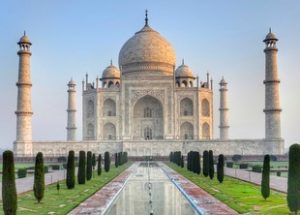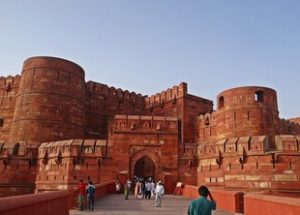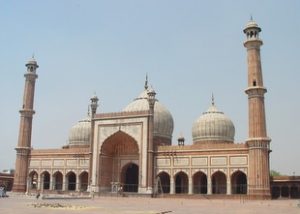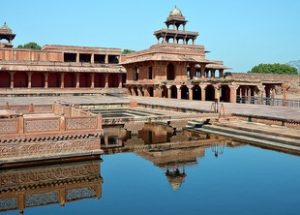Almost every other Indian has come across Agra’s name, haven’t we? And why would we not? This place is home to our pride heritage site, the symbol of our Indian history and culture – the Taj Mahal, and many other beautiful sites. Anywhere you look in Agra, the place bears a mark of the abounding history of our rich and colourful past. No wonder people from all across the globe come to visit this place.
A paradise for history buffs, Agra has enticed people of all ages from different generations. And it is primarily for this reason that we have taken it upon ourselves to list the top 9 places that you must visit while in Agra.
Taj Mahal
You cannot think of Agra without thinking of Taj Mahal. Rabindranath Tagore described it as “a teardrop on the cheek of eternity.” Recognised by the UNESCO as a world heritage site, the Taj Mahal is among the seven wonders of the world. The designs of this structure incorporate Persian and Mughal architecture.
Mughal Emperor Shah Jahan built Taj Mahal as a memorial for his third wife, Mumtaz Mahal. It stands for Crown of Palaces in the Persian language. It rises from the dust beaten earth of Agra, but even the wildest imaginations leave visitors underprepared for this magnificent beauty. The construction of the Taj Mahal began in 1648.
Made up of white marble, the tomb is laid out in a rectangular shape and can be approached through a massive gateway which has an arch and alcoves on either side of it. The paint was the chief constituent for the decorations. In accordance with the Islamic doctrine prohibition, there are no anthropomorphic forms anywhere in the design scheme. Multiple verses from Qur’an and precious gemstones decorate the interior walls. The Taj Mahal overlooks the Yamuna river, an artificial pool, and a stunning garden with an avenue of trees neatly lined. Author Rudyard Kipling remarked that Taj Majal is “the embodiment of all things pure,” and rightly it is so. Visting this wonder becomes a priority when you are in Agra.
Itmad-Ud-Daulah
Itmad-Ud-Daulah signals the beginning of a new era in Mughal architecture. Made up of white marble, it is often referred to as the “baby Taj” or a draft of the Taj Mahal, as it has been constructed with the same elaborate carvings and pietra dura (cut-out stonework) inlay techniques.
The 21-metre high tomb was constructed in memory of Mirza Ghiyas, who was the father-in-law of Jahangir. Influenced by Islamic architectural style, the monuments’ towers display Persian touch. Surrounded by magnificent gardens, the tomb makes the perfect site to relax and experience the beauty of an old era that abounded in rich art, culture, and history.
Agra Fort
The Agra Fort is yet another 16th-century architectural brilliance of the Mughals. The Red Fort of Agra is the other name of Agra Fort. It is a massive fortification located on the right bank of the River Yamuna in Agra. The fort was once the erstwhile residence of the Mughals until the year 1638. One of the UNESCO World Heritage Sites, it lies at a distance of 2.5km from the Taj Mahal.
The fortress comprises of many palaces namely, Jahangir Palace, Khas Mahal and so on. The Shish Mahal has some splendid reception rooms. Additionally, Agra Fort also has two mosques inside it – Moti Masjid and Nagina Masjid. The Moti Masjid is exquisitely enthralling and stays true to its name as it reflects a pearl-like shine under the sun’s glare. The entire fortress is a symbol of Mughal’s grandeur. Each and every one of the edifices have remarkable handiwork and ornamentation that make this place a delight for every history and architecture lover. Aurangazeb held his father, Shah Jahan, a prisoner in Agra Fort. Here, Shah Jahan spent his last days viewing the monument he had built for his wife.
Mehtab Bagh
It is located just opposite the Taj Mahal. Mehtab Bagh is a four garden complex. It is the ideal viewing point of the Taj Mahal. Colloquially known as the Moonlight Garden, it is perfectly quadrilateral in shape. The magnificent Mehtab Bagh is the last one of the eleven similar Mughal-built garden complexes along the Yamuna bank. Mehtab Bagh is a popular sunset spot among the photography fanatics and nature enthusiasts.
The exquisite garden has four sandstone towers, one each at the corner with a huge octagonal tank in the centre. Shah Jahan designed this garden exclusively for his own interests so he could come here to admire the beauty of the Taj Mahal. Mehtab Bagh is now a horticulture delight with scores of vibrantly blooming floral plants and medicinal herbs, besides the alignment of various fruit trees, which only increases the beauty of this park.
Jama Masjid
Jama Masjid is one of the largest mosques built by the Mughals in India. Shah Jahan built this mosque in 1648. Jama Masjid was dedicated to the Emperor’s favourite daughter, Jahan Ara Begum and was originally called Masjid Jahan Numa. This splendid beauty is visible from Agra Fort with the Agra Fort Railway station right between the two structures. The construction of the mosque has had a huge significance in Indian history and culture.
Made up of red sandstone and white marble, Jama Masjid bears testimony to the magnificent Mughal architecture. Supported by four kiosks in the courtyard, the mosque has a fountain at the centre. The interior walls have scriptures in the Persian style praising Shah Jahan and Jahan Ara. The inlaid panels have similarities with Taj Mahal and other Mughal monuments. Thousands of devotees attend special prayers conducted every Friday.
Akbar’s Tomb
The Tomb of Akbar is the final resting place of the great Mughal Emperor, Akbar. Made up of sandstone and white marble, it is an important architectural masterpiece of the Mughal era. Built-in the early 1600s, it is located in Sikandra, a suburb of Agra. Following the Tartary custom, the construction of this tomb was overseen by the Akbar himself but after his death, it was completed by his son, Salim. One interesting fact about this tomb is that instead of facing Masjid of Mecca like other Mughal tombs, it faces east.
Akbar’s tomb resides in more than 119 acres of land. The building is four-tiered and pyramidical in shape which is surrounded by high walls. The entry is through the South Gate and is flanked by four minarets. The panels that have been inlaid into the tomb are decorated with intricate carvings with different geometric floral pattern. Mariam-uz-Zamani Begam’s tomb is located one kilometre away from this site.
Fatehpur Sikri
Fatehpur Sikri was the capital city of the Mughal Empire for many years before Agra took this position. Mughal Emperor Akbar was the founder of Fatehpur Sikri. He commissioned the building of gardens, harems, planned roads, mosques, and utility structures. Made up of red sandstone, Fatehpur Sikri gives the site a perfect blend of Indian, Islamic and Persian architecture.
The city has a 6-kilometre long wall on three sides and there are several beautiful towers and gates. It houses some of the city’s important buildings namely Buland Darwaza, Birbal’s House, Jodha Bai’s Palace, Panch Mahal and Jama Masjid which are an integral part of Indian heritage.
Wildlife SOS
Established in 1995, Wildlife SOS is a laudatory initiative started by a group of individuals to conserve India’s wildlife, safeguarding biodiversity and maintaining quality habitats. This place is popular for creating sustainable livelihood measures, the movement which elaborately makes an effort to protect the depleting environment. Although Wildlife SOS initially started to rescue the “dancing bears” of India, it also runs active projects to provide shelter and help to leopards, elephants, reptiles, and other animals.
Wildlife SOS offers a personal two-hour guided experience that involves a touring the facility. A documentary explains the history of dancing bears. Activities to interact with bears, such as feeding them fruits or porridge is available. The centre remains open for seven days of the week, from sunrise to sunset.
Kinari Bazar
Wanna experience what a gale of past in Agra? Then head straight to Kinari Bazar. The bazar is located in the narrow streets behind Jama Masjid. The bazar will welcome you to shops with a multitude of colour, the suburban rush and orientalism. Clothes, jewellery, shoes – you name it, the place has it. Additionally, there are various authentic snack stalls and Agra’s renowned marble-work can be found. The place is catchy for its shops which sell wedding beautiful crafted garlands, bridal veils, and groom turbans. A visit to this place becomes mandatory as soon as you step within Agra.
So here are ‘Top 9 places that you must visit in Agra!’ We certainly hope you enjoyed this article as much as we enjoyed writing it and enlightening you with the knowledge. Leave a comment below if you have been to Agra or you wish to visit in the future. Share your experience and let us know your take on this historical magnificent place.
Explore Our Other Posts. Tap Here!
Get the latest updates on Instagram!






